Abstract
An unregulated, elevated rebound of antibody levels in rabbits was shown to follow late (10 to 15 days) after steptococcal pyrogenic exotoxin (SPE)-induced immunosuppression. Because of that result we have suggested that SPE acts by preferentially inhibiting a regulatory cell which normally limits the extent of full expression of antibody formation by B-cells. We are currently testing this hypothesis in mice. NIH (Swiss Webster) mice (+/+) or NIH (Swiss Webster) mice heterozygous (+/nu) for the mutant athymic nude gene and phenotypically normal showed an elevated plaque-forming cell (PFC) response to sheep erythrocytes (SE) late (10 to 15 days) after immunosuppressive SPE treatment similar to that described in rabbits. Homozygous nude mice (nu/nu) that are phenotypically athymic normally show a reduced early (4 day) PFC response to SE (a T-cell-dependent antigen) as compared with +/nu littermates or +/+ parent strain mice. This cryptic early 4-day response was improved by injection of purified endotoxin (a B-cell mitogen), but these relatively elevated nude PFC responses had decreased to normal control (SE only)nude PFC levels before 10 days. In similar SE-injected nude mice treated instead with SPE, no elevation at 4 days was observed and, more pertinently, the late (10 to 15 day) elevated rebound of PFC levels observed in normal response controls (+/nu or +/+) was not observed. Similar experiments were subsequently conducted in Marbrook-type spleen PFC cultures during periods of 12 days. The results of these experiments paralleled the in vivo results above, and in addition showed that SPE induced a large proliferation of either +/+ or +/nu cells (T-and B-cells) in culture but had no such effect on nu/nu cells (B-cells) in culture. Purified endotoxin, the Bcell mitogen, had a better sparing effect on nu/nu cells in this respect. These results are consistent with our premise that SPE inhibits preferentially the function of a regulator of the antibody response. The regulator appears to be a T-cell and is likely a suppressor T-cell.
Full text
PDF
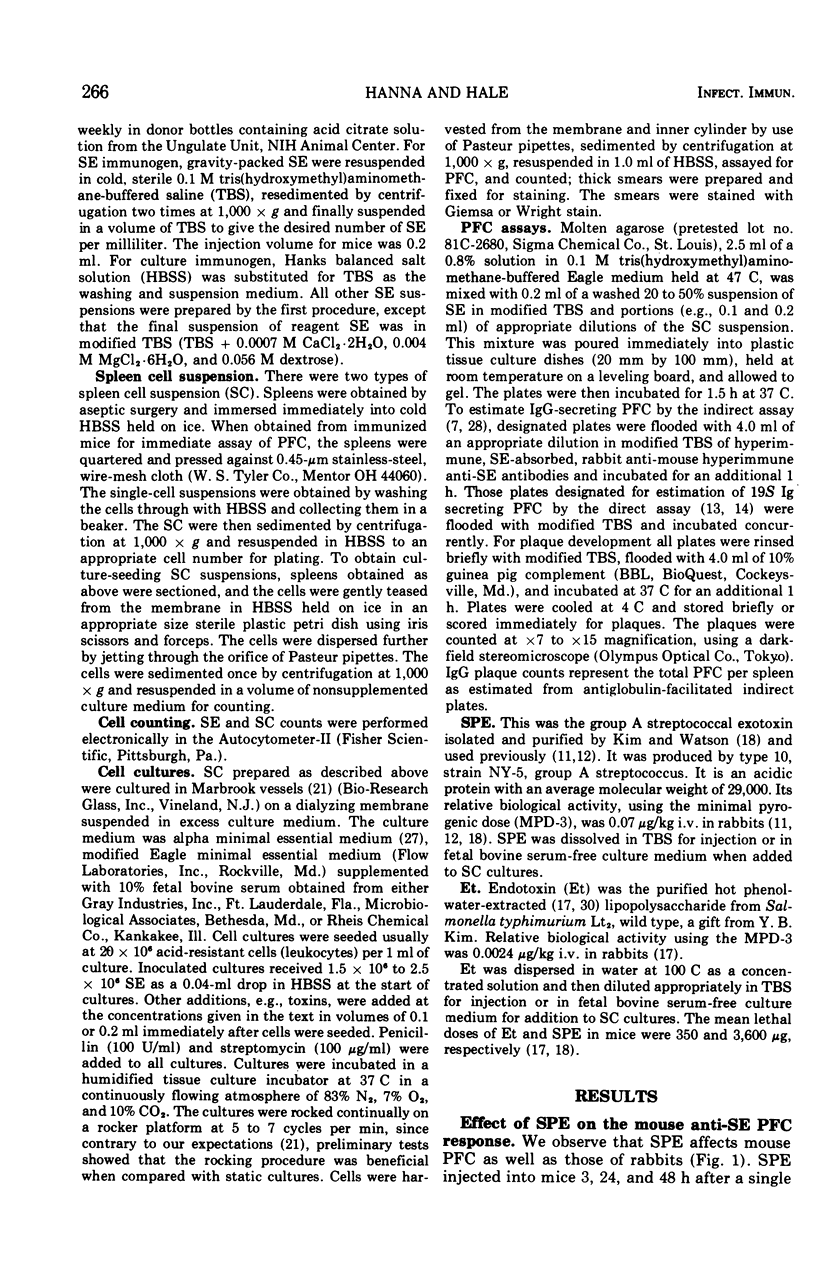
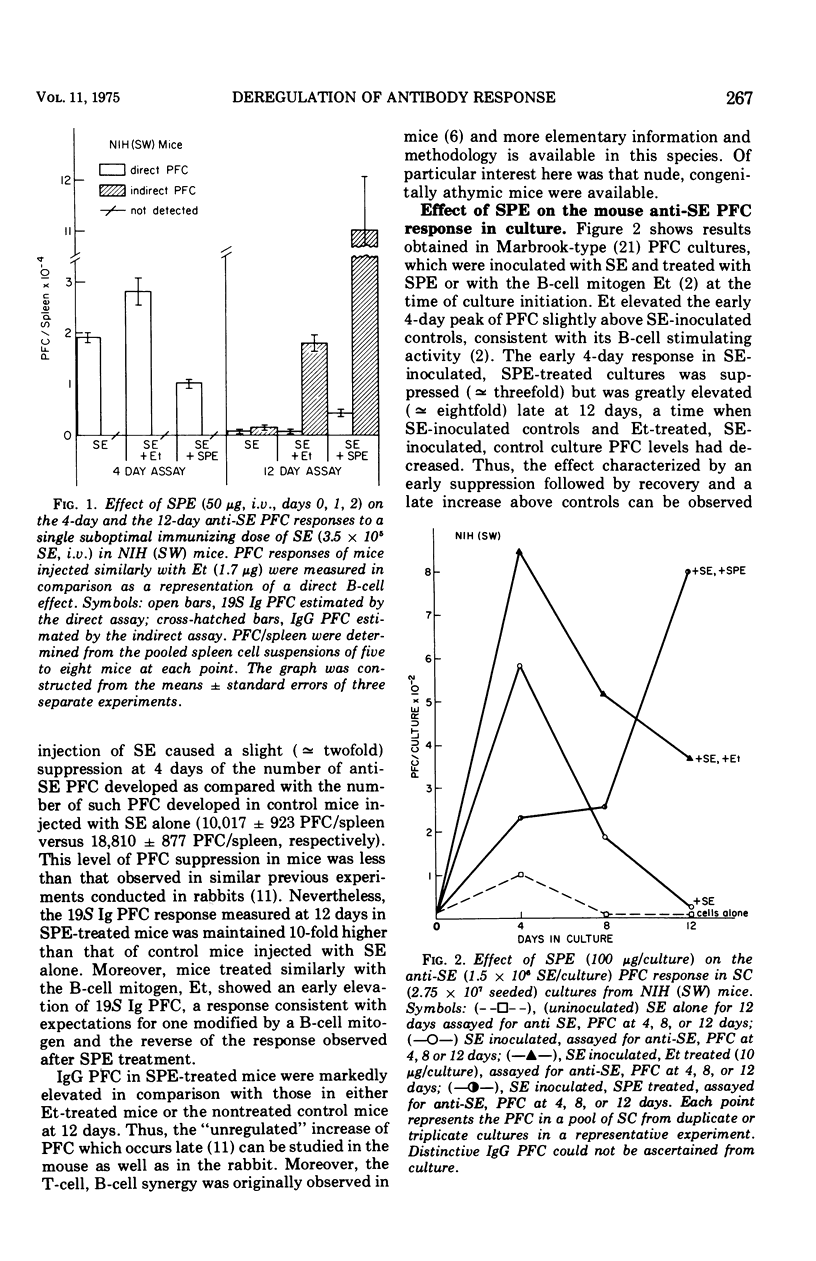
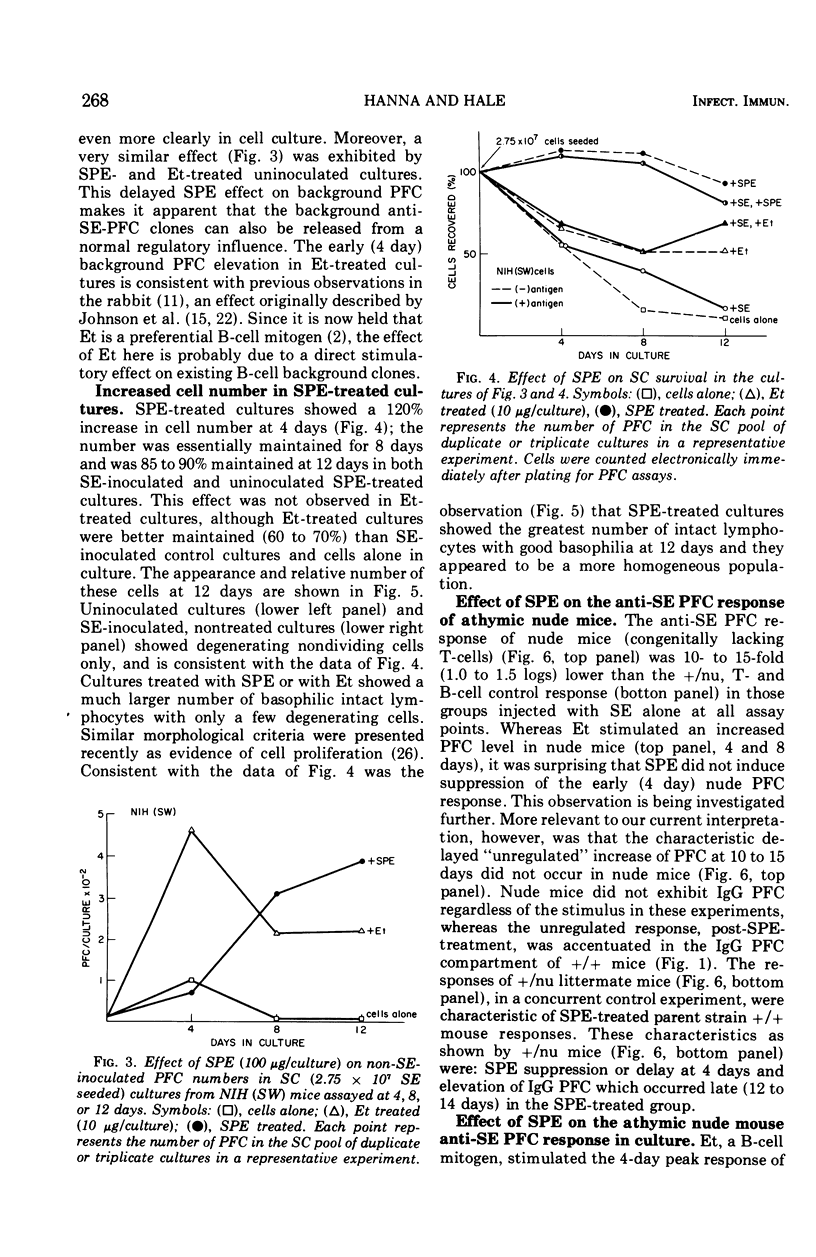
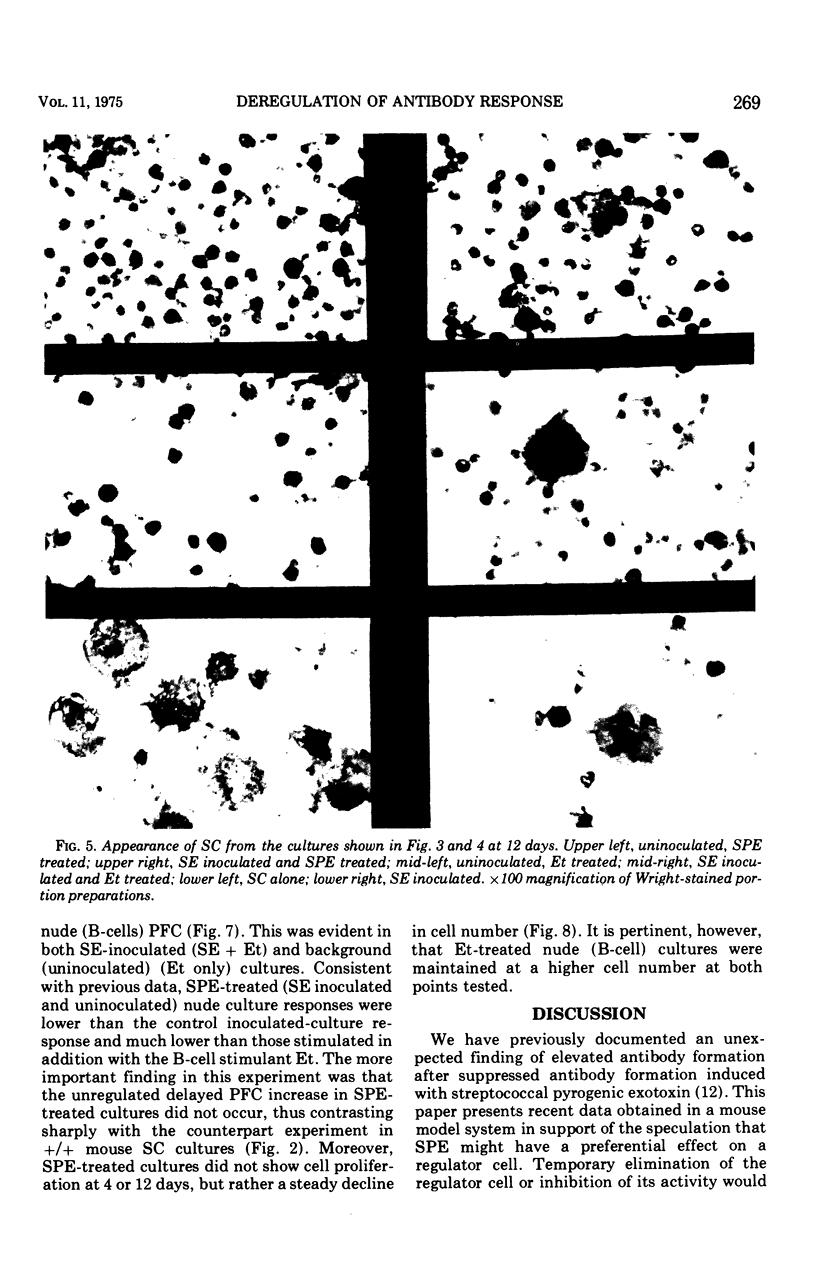
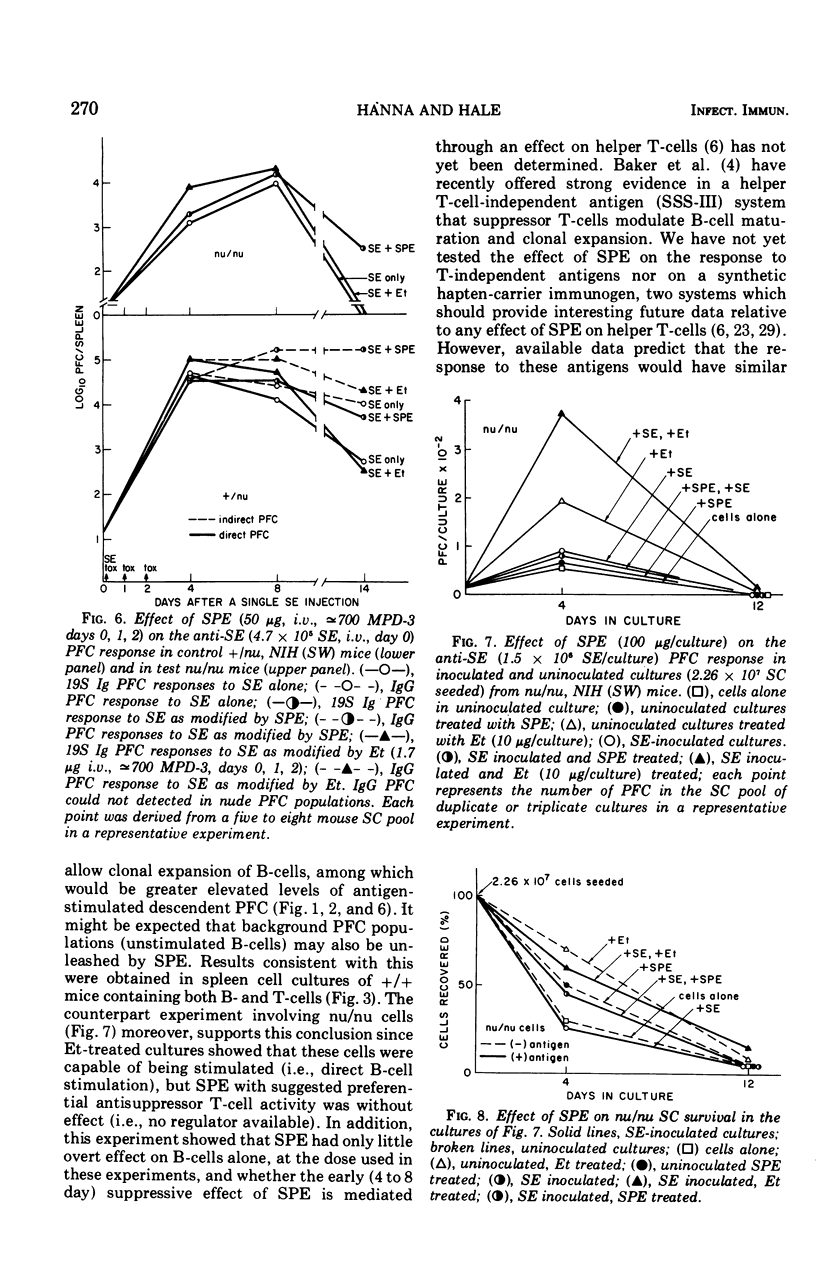
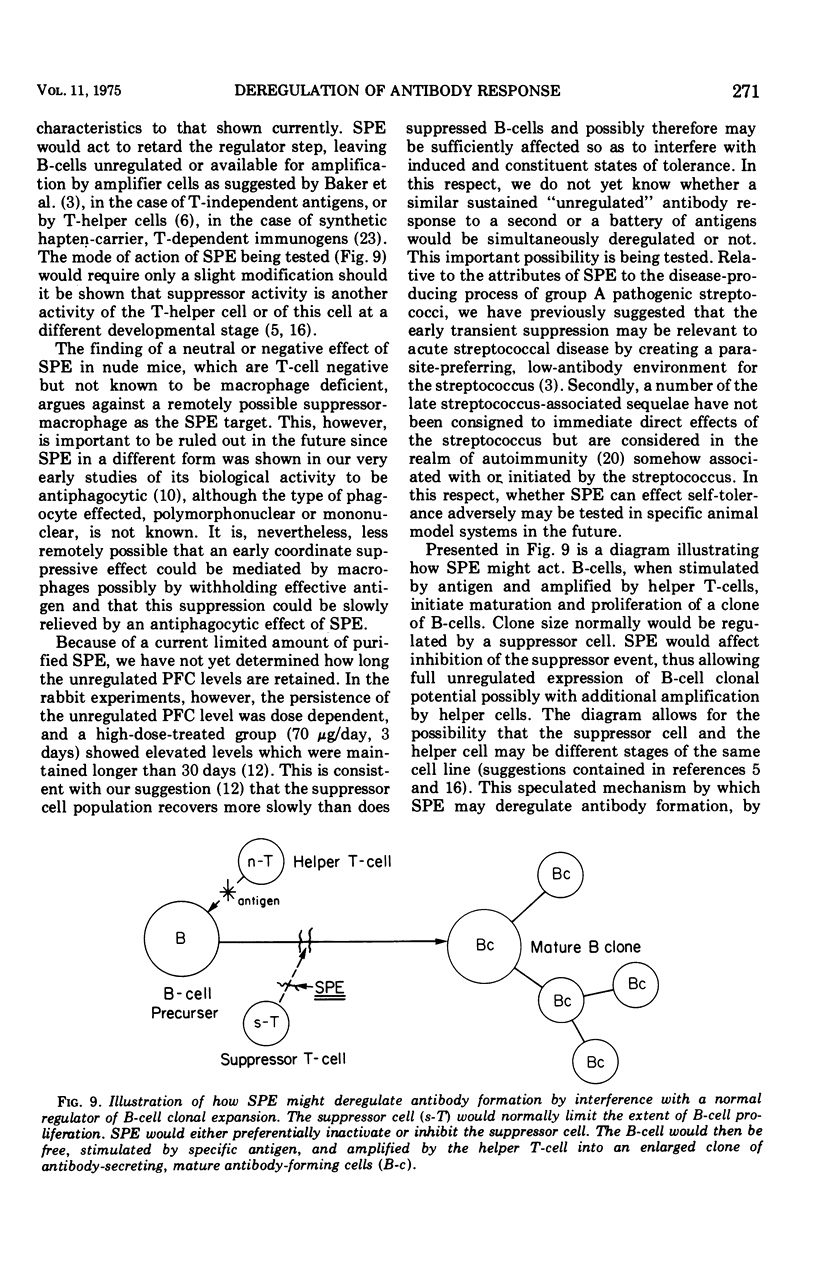
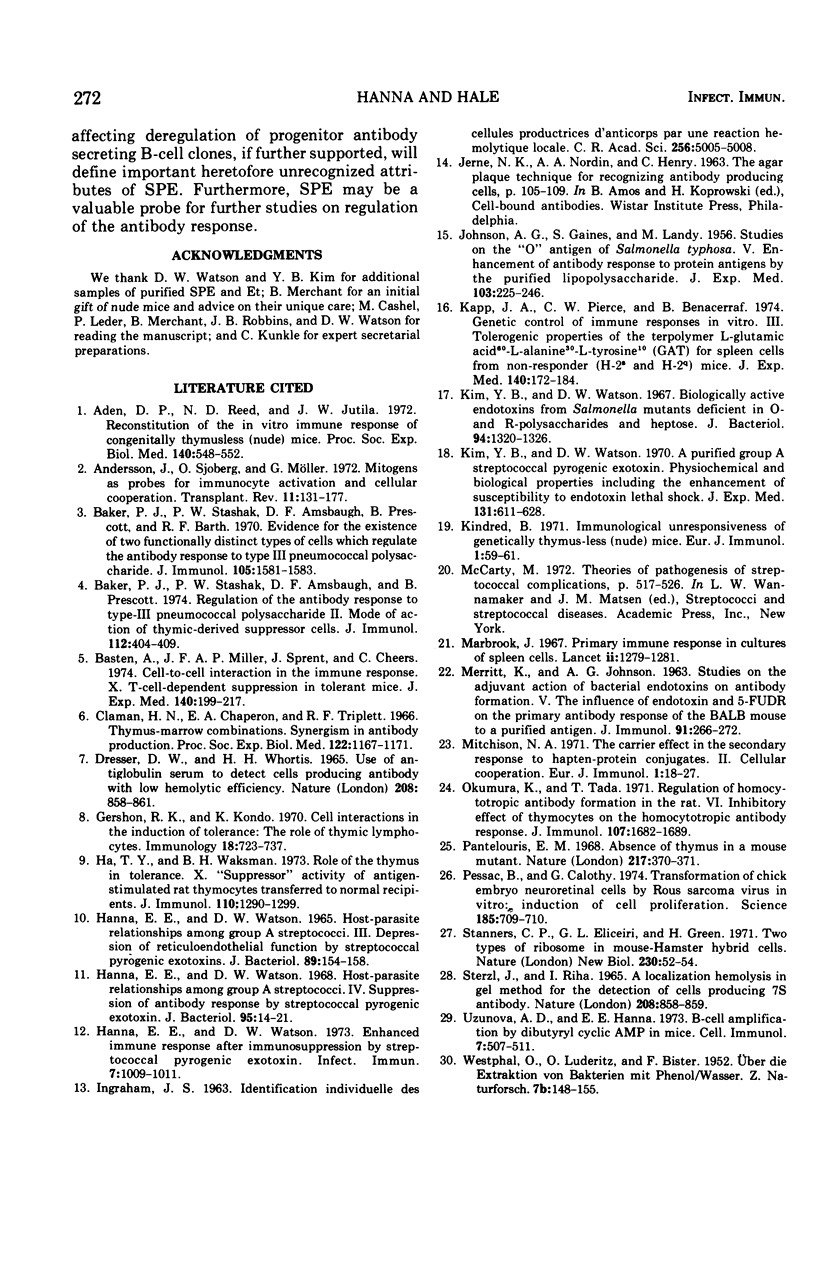
Images in this article
Selected References
These references are in PubMed. This may not be the complete list of references from this article.
- Aden D. P., Reed N. D., Jutila J. W. Reconstitution of the in vitro immune response of congenitally thymusless (nude) mice. Proc Soc Exp Biol Med. 1972 Jun;140(2):548–552. doi: 10.3181/00379727-140-36500. [DOI] [PubMed] [Google Scholar]
- Andersson J., Sjöberg O., Möller G. Mitogens as probes for immunocyte activation and cellular cooperation. Transplant Rev. 1972;11:131–177. doi: 10.1111/j.1600-065x.1972.tb00048.x. [DOI] [PubMed] [Google Scholar]
- Baker P. J., Stashak P. W., Amsbaugh D. F., Prescott B., Barth R. F. Evidence for the existence of two functionally distinct types of cells which regulate the antibody response to type 3 pneumococcal polysaccharide. J Immunol. 1970 Dec;105(6):1581–1583. [PubMed] [Google Scholar]
- Baker P. J., Stashak P. W., Amsbaugh D. F., Prescott B. Regulation of the antibody response to type 3 pneumococcal polysaccharide. II. Mode of action of thymic-derived suppressor cells. J Immunol. 1974 Jan;112(1):404–409. [PubMed] [Google Scholar]
- Basten A., Miller J. F., Sprent J., Cheers C. Cell-to-cell interaction in the immune response. X. T-cell-dependent suppression in tolerant mice. J Exp Med. 1974 Jul 1;140(1):199–217. doi: 10.1084/jem.140.1.199. [DOI] [PMC free article] [PubMed] [Google Scholar]
- Claman H. N., Chaperon E. A., Triplett R. F. Thymus-marrow cell combinations. Synergism in antibody production. Proc Soc Exp Biol Med. 1966 Aug-Sep;122(4):1167–1171. doi: 10.3181/00379727-122-31353. [DOI] [PubMed] [Google Scholar]
- Dresser D. W., Wortis D. H. Use of an antiglobulin serum to detect cells producing antibody with low haemolytic efficiency. Nature. 1965 Nov 27;208(5013):859–861. doi: 10.1038/208859a0. [DOI] [PubMed] [Google Scholar]
- Gershon R. K., Kondo K. Cell interactions in the induction of tolerance: the role of thymic lymphocytes. Immunology. 1970 May;18(5):723–737. [PMC free article] [PubMed] [Google Scholar]
- HANNA E. E., WATSON D. W. HOST-PARASITE RELATIONSHIPS AMONG GROUP A STREPTOCOCCI. 3. DEPRESSION OF RETICULOENDOTHELIAL FUNCTION BY STREPTOCOCCAL PYROGENIC EXOTOXINS. J Bacteriol. 1965 Jan;89:154–158. doi: 10.1128/jb.89.1.154-158.1965. [DOI] [PMC free article] [PubMed] [Google Scholar]
- Ha T. Y., Waksman B. H. Role of the thymus in tolerance. X. "Suppressor" activity of antigen-stimulated rat thymocytes transferred to normal recipients. J Immunol. 1973 May;110(5):1290–1299. [PubMed] [Google Scholar]
- Hanna E. E., Watson D. W. Enhanced immune response after immunosuppression by Streptococcal pyrogenic exotoxin. Infect Immun. 1973 Jun;7(6):1009–1011. doi: 10.1128/iai.7.6.1009-1011.1973. [DOI] [PMC free article] [PubMed] [Google Scholar]
- Hanna E. E., Watson D. W. Host-parasite relationships among group A streptococci. IV. Suppression of antibody response by streptococcal pyrogenic exotoxin. J Bacteriol. 1968 Jan;95(1):14–21. doi: 10.1128/jb.95.1.14-21.1968. [DOI] [PMC free article] [PubMed] [Google Scholar]
- INGRAHAM J. [Individual identification of antibody-producing cells by a local hemolytic reaction]. C R Hebd Seances Acad Sci. 1963 Jun 5;256:5005–5008. [PubMed] [Google Scholar]
- JOHNSON A. G., GAINES S., LANDY M. Studies on the O antigen of Salmonella typhosa. V. Enhancement of antibody response to protein antigens by the purified lipopolysaccharide. J Exp Med. 1956 Feb 1;103(2):225–246. doi: 10.1084/jem.103.2.225. [DOI] [PMC free article] [PubMed] [Google Scholar]
- Kapp J. A., Pierce C. W., Benacerraf B. Genetic control of immune responses in vitro. 3. Tolerogenic properties of the terpolymer L-glutamic acid 60-L-alanine30-L-tyrosine10 (GAT) for spleen cells from nonresponder (H-2s and H-2q) mice. J Exp Med. 1974 Jul 1;140(1):172–184. doi: 10.1084/jem.140.1.172. [DOI] [PMC free article] [PubMed] [Google Scholar]
- Kim Y. B., Watson D. W. A purified group A streptococcal pyrogenic exotoxin. Physiochemical and biological properties including the enhancement of susceptibility to endotoxin lethal shock. J Exp Med. 1970 Mar 1;131(3):611–622. doi: 10.1084/jem.131.3.611. [DOI] [PMC free article] [PubMed] [Google Scholar]
- Kim Y. B., Watson D. W. Biologically active endotoxins from Salmonella mutants deficient in O- and R-polysaccharides and heptose. J Bacteriol. 1967 Nov;94(5):1320–1326. doi: 10.1128/jb.94.5.1320-1326.1967. [DOI] [PMC free article] [PubMed] [Google Scholar]
- Kindred B. Immunological unresponsiveness of genetically thymusless (nude) mice. Eur J Immunol. 1971 Jan;1(1):59–61. doi: 10.1002/eji.1830010114. [DOI] [PubMed] [Google Scholar]
- MERRITT K., JOHNSON A. G. STUDIES ON THE ADJUVANT ACTION OF BACTERIAL ENDOTOXINS ON ANTIBODY FORMATION. V. THE INFLUENCE OF ENDOTOXIN AND 5-FLUORO-2-DEOXYURIDINE ON THE PRIMARY ANTIBODY RESPONSE OF THE BALB MOUSE TO A PURIFIED PROTEIN ANTIGEN. J Immunol. 1963 Aug;91:266–272. [PubMed] [Google Scholar]
- Marbrook J. Primary immune response in cultures of spleen cells. Lancet. 1967 Dec 16;2(7529):1279–1281. doi: 10.1016/s0140-6736(67)90393-5. [DOI] [PubMed] [Google Scholar]
- Mitchison N. A. The carrier effect in the secondary response to hapten-protein conjugates. II. Cellular cooperation. Eur J Immunol. 1971 Jan;1(1):18–27. doi: 10.1002/eji.1830010104. [DOI] [PubMed] [Google Scholar]
- Okumura K., Tada T. Regulation of homocytotropic antibody formation in the rat. VI. Inhibitory effect of thymocytes on the homocytotropic antibody response. J Immunol. 1971 Dec;107(6):1682–1689. [PubMed] [Google Scholar]
- Pantelouris E. M. Absence of thymus in a mouse mutant. Nature. 1968 Jan 27;217(5126):370–371. doi: 10.1038/217370a0. [DOI] [PubMed] [Google Scholar]
- Pessac B., Calothy G. Transformation of chick embryo neuroretinal cells by Rous sarcoma virus in vitro: induction of cell proliferation. Science. 1974 Aug;185(4152):709–710. doi: 10.1126/science.185.4152.709. [DOI] [PubMed] [Google Scholar]
- Stanners C. P., Eliceiri G. L., Green H. Two types of ribosome in mouse-hamster hybrid cells. Nat New Biol. 1971 Mar 10;230(10):52–54. doi: 10.1038/newbio230052a0. [DOI] [PubMed] [Google Scholar]
- Sterzl J., Ríha I. Detection of cells producing 7S antibodies by the plaque technique. Nature. 1965 Nov 27;208(5013):858–859. doi: 10.1038/208858a0. [DOI] [PubMed] [Google Scholar]
- Uzunova A., Hanna E. E. B-cell amplification by dibutyryl cyclic AMP in mice. Cell Immunol. 1973 Jun;7(3):507–511. doi: 10.1016/0008-8749(73)90214-1. [DOI] [PubMed] [Google Scholar]



